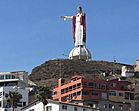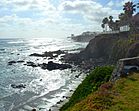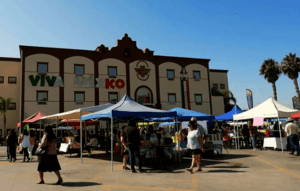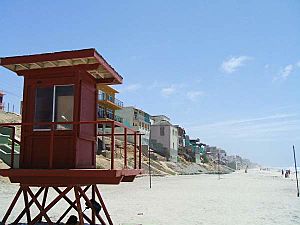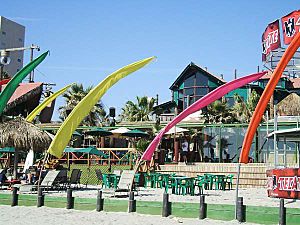Rosarito facts for kids
Quick facts for kids
Rosarito
|
||
|---|---|---|
|
Top: Cristo del Sagrado Corazón statue (left) and Rosarito's Pacific Coast; bottom: Rosarito Beach Hotel (left) and the Muelle de Rosarito (right).
|
||
|
||
| Motto(s):
A Horizon of Possibilities
|
||
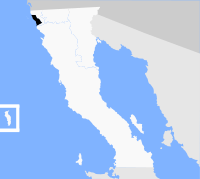
Location of Rosarito in Baja California
|
||
| Country | ||
| State | ||
| Municipality | Playas de Rosarito | |
| Municipality established | June 29, 1995 | |
| Area | ||
| • Total | 35.71 km2 (13.79 sq mi) | |
| Elevation | 14 m (46 ft) | |
| Population
(2020 census)
|
||
| • Total | 100,660 | |
| • Density | 2,818.8/km2 (7,300.7/sq mi) | |
| Time zone | UTC−08:00 (PST) | |
| • Summer (DST) | UTC−07:00 (PDT) | |
| Area code(s) | 661 | |
| Website | http://www.rosarito.gob.mx | |
| Sources: INEGI, Enciclopedia de los Municipios de México | ||
Rosarito is a fun city located right on the coast in Playas de Rosarito Municipality, Baja California, Mexico. It sits along the beautiful Pacific Coast of Mexico. In 2010, about 65,278 people lived there. Rosarito is only about 10 miles (16 km) south of the US–Mexico border. This makes it part of the larger San Diego–Tijuana area. It is also one of the westernmost cities in Mexico. Rosarito is a very popular place for tourists. People love its beaches, fancy resorts, and cool events like Baja Beach Fest.
Contents
History of Rosarito: From Ancient Times to Today
People have lived in the Rosarito area for a very long time. Early Native American groups, called Paleo-Indians, were here as far back as 2,000 BC. By 1,000 BC, the Kumeyaay people, who are ancestors of the Yuman tribes, lived here. They called the area Wa-cuatay, which means "big houses" in their language.
Spanish Explorers and Missions
After the Spanish took over the Aztec Empire, they sent explorers to find new lands. In 1533, Fortún Ximénez was the first European to land in Baja California. Later, in 1542, Juan Rodríguez Cabrillo sailed past the Rosarito area.
The first lasting European settlement in Baja California was a Jesuit mission in Loreto in 1697. For many years, different religious groups, like the Jesuits, Dominicans, and Franciscans, argued over who would control the area.
In 1773, a border was set up. It separated "New" or "Upper" California (controlled by Franciscans) from "Old" or "Lower" California (controlled by Dominicans). In 1788, a Dominican priest named Luis de Sales moved the border. It then reached the Rosarito Arroyo, which was called the Barrabas Arroyo back then.
Because the Mission San Miguel often flooded, a new mission was built. In 1817, Father Tomás de Ahumada started the Misión El Descanso about 22 km (14 miles) south of where Rosarito is today. This new spot had good land for farming and grazing animals.
Ranch Life in Rosarito
The first large ranch in the Rosarito area was called Rancho El Rosario. It was given to Don José Manuel Machado in 1827. He was one of the first soldiers at the Presidio of San Diego. This ranch was very large, covering about 11 leagues (a league is an old unit of distance). It stretched from Rancho Tía Juana in the north to the Pacific Ocean in the west.
In 1830, an adobe (mud-brick) church was built here. However, by 1834, the mission stopped working. The ruins of Misión El Descanso can still be seen today.
Don Joaquín Machado, José Manuel Machado's son, officially asked for the land as Rancho Rosarito. On May 14, 1885, he received the title. This date is now celebrated as Rosarito's Foundation Day!
Modern Rosarito: A City Grows
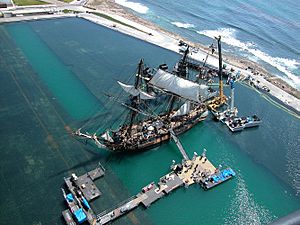
On December 1, 1995, Rosarito became its own independent city. Before that, it was part of Tijuana. Hugo Torres Chabert, who owns the Rosarito Beach Hotel, helped make this happen. He later became the city's mayor.
Rosarito is located on the coast of the Pacific Ocean. It sits between the ocean and the hills of the Peninsular Ranges. The land is mostly flat.
In the 1950s, Rosarito started to grow quickly. Streets and city blocks were planned and built. More land was sold, and small restaurants, shops, and hotels opened. This helped the city look more like it does today. In the 1960s, Rosarito became more industrial. A large power plant was built, and Pemex, Mexico's state-owned oil company, set up operations there.
Today, Rosarito has many tall, luxurious resorts along its coast. Most of these buildings are on Boulevard Benito Juárez, which is the city's main street. More tall buildings for homes and businesses are still being built along the coast, heading towards both Tijuana and Ensenada.
Geography and Climate of Rosarito
Rosarito has a semi-arid climate. This means it's usually dry, but it gets some rain, mostly in winter. The weather is greatly affected by the cold California Current in the ocean. Because of this, temperatures are mild all year round. Average temperatures are usually between 14.3°C (57.7°F) and 20.9°C (69.6°F).
The city gets about 261 mm (10.3 inches) of rain each year. Most of this rain falls in the winter months. March is usually the wettest month, while July is the driest. Winters are cool, with an average temperature of 14.3°C (57.7°F) in February and March. Summers are warm, with an average of 20.9°C (69.6°F) in August.
| Climate data for Rosarito | |||||||||||||
|---|---|---|---|---|---|---|---|---|---|---|---|---|---|
| Month | Jan | Feb | Mar | Apr | May | Jun | Jul | Aug | Sep | Oct | Nov | Dec | Year |
| Record high °C (°F) | 33.5 (92.3) |
32.5 (90.5) |
31.5 (88.7) |
31.0 (87.8) |
34.5 (94.1) |
40.0 (104.0) |
32.0 (89.6) |
34.0 (93.2) |
41.5 (106.7) |
38.0 (100.4) |
36.5 (97.7) |
31.5 (88.7) |
41.5 (106.7) |
| Mean daily maximum °C (°F) | 19.1 (66.4) |
19.0 (66.2) |
18.6 (65.5) |
19.7 (67.5) |
20.6 (69.1) |
21.8 (71.2) |
23.2 (73.8) |
24.9 (76.8) |
24.2 (75.6) |
23.3 (73.9) |
21.3 (70.3) |
19.6 (67.3) |
21.3 (70.3) |
| Daily mean °C (°F) | 14.5 (58.1) |
14.3 (57.7) |
14.3 (57.7) |
15.3 (59.5) |
16.6 (61.9) |
18.1 (64.6) |
19.5 (67.1) |
20.9 (69.6) |
20.1 (68.2) |
19.0 (66.2) |
16.6 (61.9) |
14.9 (58.8) |
17.0 (62.6) |
| Mean daily minimum °C (°F) | 9.8 (49.6) |
9.6 (49.3) |
9.9 (49.8) |
11.0 (51.8) |
12.6 (54.7) |
14.4 (57.9) |
15.9 (60.6) |
16.9 (62.4) |
16.0 (60.8) |
14.6 (58.3) |
11.9 (53.4) |
10.3 (50.5) |
12.7 (54.9) |
| Record low °C (°F) | 2.0 (35.6) |
2.0 (35.6) |
1.0 (33.8) |
2.0 (35.6) |
7.0 (44.6) |
10.0 (50.0) |
10.0 (50.0) |
10.0 (50.0) |
9.0 (48.2) |
6.0 (42.8) |
0.0 (32.0) |
1.5 (34.7) |
0.0 (32.0) |
| Average precipitation mm (inches) | 50.5 (1.99) |
52.4 (2.06) |
56.5 (2.22) |
17.3 (0.68) |
7.6 (0.30) |
1.1 (0.04) |
0.0 (0.0) |
2.2 (0.09) |
6.1 (0.24) |
9.6 (0.38) |
27.1 (1.07) |
30.3 (1.19) |
260.7 (10.26) |
| Average precipitation days (≥ 0.1 mm) | 5.5 | 5.7 | 6.9 | 3.3 | 2.0 | 0.6 | 0.0 | 0.5 | 1.2 | 2.0 | 3.6 | 4.1 | 35.4 |
| Source: Servicio Meteorológico Nacional | |||||||||||||
Culture and Tourism in Rosarito
Rosarito has always been a popular place for tourists. It started with the Ortiz family opening Rene's (a bar, restaurant, trailer park, and motel) in 1925. Rene Ortiz was a very important person in Rosarito. He served as the Delegado (Mayor) for a long time. Rene helped Rosarito grow from a ranch into a town, and then into a city. When he couldn't serve anymore, he chose Hugo Torres Chabert, the owner of the Rosarito Beach Hotel, to follow him.
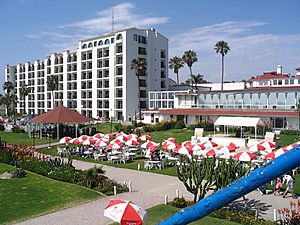
During the 1920s and 30s, when alcohol was banned in the U.S. (this was called Prohibition), many Americans came to Mexico. Drinking was still allowed here. While Tijuana was known for its secret bars, Rosarito became a favorite spot for wealthier people and Hollywood stars. Famous actors like Orson Welles and Dolores del Río visited. They enjoyed hunting and fishing for lobster and abalone. Even Rita Hayworth and her husband, Prince Aly Khan, would stay at the Rosarito Beach Hotel. They would rent an entire floor and bring their own staff! Other stars like Mickey Rooney, Ava Gardner, Spencer Tracy, and Katharine Hepburn also visited.
Hugo Torres Chabert, who is related to the founder of the Rosarito Beach Hotel, led the effort to make Rosarito an independent city in 1995. He was then appointed mayor for three years. In 2007, he was elected mayor again. He worked hard to make sure tourists felt safe in the city.
Did you know that the famous "Pet Rocks" from the 1970s came from Rosarito? The rocks used for this popular toy were found here!
In 1996, the movie team for Titanic moved to the new Baja Studios in Rosarito. They built a full-sized replica of the RMS Titanic ship there for the movie. The film studio, owned by Fox, bought 40 acres of land by the water south of Rosarito. Some scenes for the movie Deep Blue Sea were also filmed at the same studio.
Getting Around Rosarito
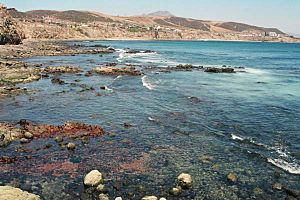
You can get to Rosarito using Mexican Federal Highway 1. There's also a toll road, tollway 1D. These highways connect Rosarito to western and Downtown Tijuana to the north. They also go south to Ensenada.
The Corredor Tijuana-Rosarito 2000 freeway links Rosarito to the Mesa de Otay area in northeast Tijuana. This road also connects to the Otay Mesa Port of Entry into the United States.
Education Opportunities in Rosarito
Rosarito has a branch of the Autonomous University of Baja California. This university offers many different bachelor's degree programs. Students can study subjects like:
- Administration and Public Accounting
- Social Sciences and Humanities
- Commerce and International Relations
- Communication and Journalism
- Education and Pedagogy
- Engineering and Technology
- Psychology
- Social Sciences of Behavior
See also
 In Spanish: Rosarito para niños
In Spanish: Rosarito para niños


